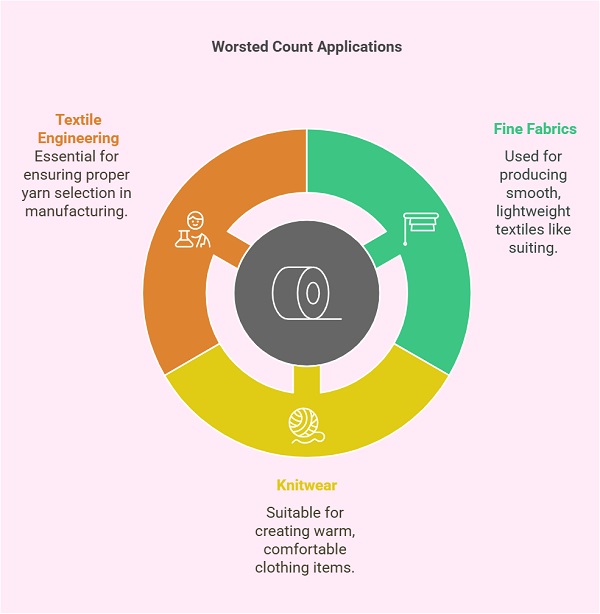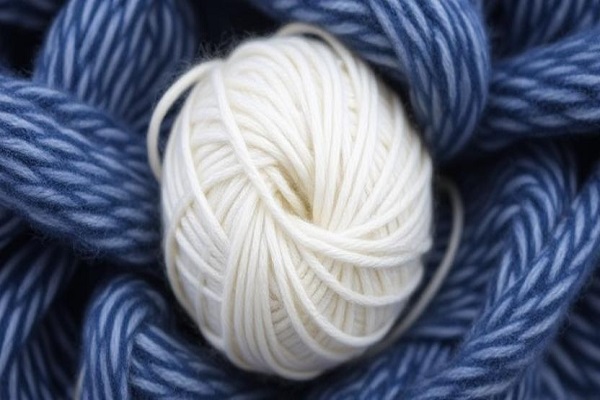Worsted Count (NeK or NeW) Calculator
© Yarn Count Ltd
Disclaimer: All tools in the Yarn Count have been reviewed by the relevant spinning industry experts.
The formula for Worsted Count Calculator (also known as NeK or NeW)
NeK = YarnLength(inyards) ÷ Weight(inpounds) × 840
Where:
- Yarn Length is the length of the yarn in yards.
- Weight is the weight of the yarn in pounds.
- The constant 840 is used to convert to the Worsted Count unit.
Table of Contents
What is Worsted Count?
Worsted Count is a system used to measure the fineness of yarn in the worsted spinning process. It is typically used for wool and wool-blended yarns. The count measures how many hanks of yarn are in one pound. A “hank” refers to a specific length of yarn, which is generally 560 yards in the case of worsted count.

The higher the Worsted Count, the finer the yarn. For example, a NeK count of 60 means there are 60 hanks of yarn per pound, which indicates a finer, lighter yarn.
Importance of Worsted Count in Textile Manufacturing
The Worsted Count plays a crucial role in determining the yarn’s characteristics, such as its strength, durability, and suitability for different applications. Manufacturers use this count to select the right yarn for specific fabric types, whether it’s for fine suiting, knitwear, or other textile products.
It also impacts fabric performance, as finer yarns (higher counts) produce smoother, lighter fabrics, while coarser yarns (lower counts) create bulkier, stronger textiles. Understanding how to calculate and interpret Worsted Count is essential for textile engineers to ensure they select the proper yarn for their production needs.
The formula for Calculating Worsted Count
The formula for calculating Worsted Count (NeK or NeW) is simple but requires careful measurement of the yarn’s length and weight. The formula can be written as:
Ne = (Yarn Length in Yards) / (Weight in Pounds x 560)
Where:
- Ne is the Worsted Count (either NeK or NeW)
- Yarn Length is the total length of the yarn
- Weight is the weight of the yarn in pounds
- 560 is the number of yards in one hank
Step-by-Step Guide to Calculating Worsted Count
Step 1: Measure the Yarn Length
The first step in the calculation process is to measure the total length of the yarn you are working with. Typically, this measurement is done in yards. For example, let’s say you have 1000 yards of yarn.
Step 2: Weigh the Yarn
Next, weigh the yarn in pounds. It’s important to ensure that the scale is accurate and that you measure the yarn’s weight correctly.
Step 3: Apply the Formula
Once you have both the yarn length and the weight, plug them into the formula:
Ne = (Yarn Length in Yards) / (Weight in Pounds x 560)
For instance, if you have 1000 yards of yarn and the weight is 0.5 pounds, the calculation would be:
Ne = 1000 / (0.5 x 560)
Ne = 1000 / 280
Ne = 3.57
This means the Worsted Count for this yarn is 3.57.
Step 4: Interpret the Result
Once you calculate the Worsted Count, you can interpret the result. A higher count indicates finer yarn, while a lower count suggests a coarser yarn. In the example above, a count of 3.57 means the yarn is relatively coarse compared to a finer count like 60 or 100.
Understanding NeK and NeW
Worsted Count is often represented by two different designations: NeK and NeW. These are essentially the same system, with “K” and “W” standing for “Knot” and “Worsted,” respectively. In both cases, the count represents the same measurement of yarn fineness. The difference in notation doesn’t affect the formula or the calculation.
Applications of Worsted Count in Textile Industry
The Worsted Count is essential for selecting yarn for various fabric types. Here are some common applications:
- Wool Fabrics: Worsted yarns with a higher count are used in wool fabrics like fine suits and tailored garments.
- Knitting Yarns: A lower Worsted Count might be used for yarns intended for knitting, where a thicker yarn is often required.
- Blended Fabrics: Blended yarns also use Worsted Count for determining the proportion of wool and other fibers, ensuring that the fabric has the desired texture and durability.
Understanding the Worsted Count helps textile engineers, designers, and manufacturers to choose the right yarn for their products, ensuring optimal performance and quality.
How Worsted Count Affects Fabric Properties

The yarn count directly influences the characteristics of the finished fabric. Let’s look at some key properties that are impacted by Worsted Count:
Strength and Durability
Finer yarns (higher counts) generally produce fabrics that are more delicate but softer. They are ideal for high-end garments where softness and smoothness are critical. Coarser yarns (lower counts), on the other hand, are stronger and more durable, making them suitable for rougher applications like outerwear or upholstery.
Texture and Appearance
Finer yarns create a smooth, polished surface, while coarser yarns tend to give the fabric a more textured, rugged appearance. The Worsted Count helps manufacturers control the texture, ensuring the fabric meets the desired aesthetic and functional requirements.
Weight and Bulk
Higher Worsted Counts result in lighter fabrics, while lower counts produce heavier, bulkier textiles. This is crucial for garments intended for specific weather conditions or for fabrics used in home textiles like blankets or curtains.
Conclusion
Worsted Count is a critical measurement in textile engineering, influencing everything from the yarn’s strength and durability to the final fabric’s texture and performance. By following a simple formula, textile professionals can calculate the Worsted Count and make informed decisions about the yarn they use for different applications. Whether working with wool, blended fibers, or other textiles, understanding Worsted Count helps ensure that the final product meets the required specifications for quality and function.